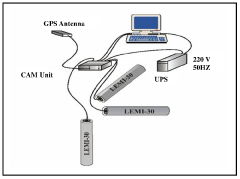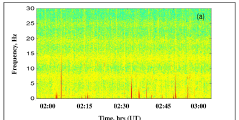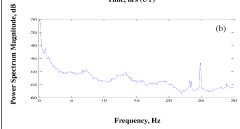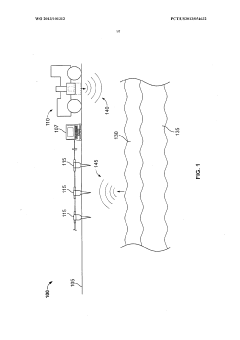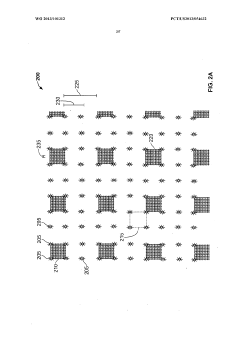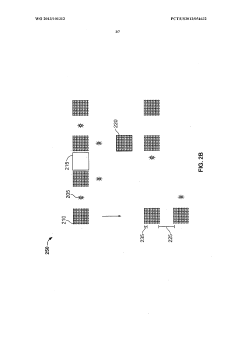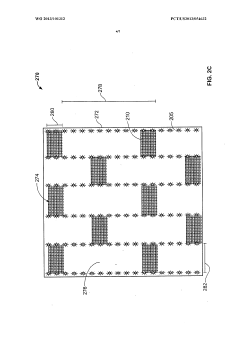Schumann Resonance: Insights into Modern Geophysics
JUN 24, 20259 MIN READ
Generate Your Research Report Instantly with AI Agent
Patsnap Eureka helps you evaluate technical feasibility & market potential.
Schumann Resonance Background and Objectives
Schumann resonances, first predicted by Winfried Otto Schumann in 1952, are a set of spectrum peaks in the extremely low frequency (ELF) portion of the Earth's electromagnetic field spectrum. These resonances occur between the Earth's surface and the ionosphere, creating a natural cavity resonator. The fundamental frequency of this phenomenon is approximately 7.83 Hz, with harmonics at higher frequencies.
The study of Schumann resonances has evolved significantly since their discovery, becoming an essential tool in modern geophysics. Initially, these resonances were primarily of interest to atmospheric scientists and radio engineers. However, their applications have expanded to encompass a wide range of geophysical and environmental studies, including climate change monitoring, earthquake prediction, and even potential implications for human health.
The primary objective of researching Schumann resonances in modern geophysics is to gain deeper insights into the Earth's electromagnetic environment and its interactions with various geophysical processes. By analyzing variations in Schumann resonance parameters, scientists aim to better understand global lightning activity, ionospheric dynamics, and the Earth's climate system.
One of the key goals is to utilize Schumann resonances as a global thermometer, monitoring changes in the Earth's temperature and humidity levels. This application is particularly valuable in the context of climate change research, as it provides a unique, globally integrated measure of atmospheric conditions.
Another important objective is to explore the potential of Schumann resonances in earthquake prediction. Some studies have suggested that changes in the resonance patterns may precede seismic events, offering a possible avenue for developing early warning systems.
Furthermore, researchers are investigating the role of Schumann resonances in the broader context of space weather. By studying how solar activity and geomagnetic storms affect these resonances, scientists hope to gain a better understanding of the complex interactions between the Earth's magnetosphere and the solar wind.
As technology advances, the methods for detecting and analyzing Schumann resonances continue to improve. This progress has led to more accurate measurements and a deeper understanding of the subtle variations in these resonances. Consequently, the field is moving towards developing more sophisticated models that can integrate Schumann resonance data with other geophysical parameters to provide a more comprehensive view of Earth's systems.
In conclusion, the study of Schumann resonances represents a fascinating intersection of atmospheric science, geophysics, and electromagnetic theory. As research in this field progresses, it promises to yield valuable insights into a wide range of Earth processes, potentially revolutionizing our understanding of the planet's complex systems and their interactions.
The study of Schumann resonances has evolved significantly since their discovery, becoming an essential tool in modern geophysics. Initially, these resonances were primarily of interest to atmospheric scientists and radio engineers. However, their applications have expanded to encompass a wide range of geophysical and environmental studies, including climate change monitoring, earthquake prediction, and even potential implications for human health.
The primary objective of researching Schumann resonances in modern geophysics is to gain deeper insights into the Earth's electromagnetic environment and its interactions with various geophysical processes. By analyzing variations in Schumann resonance parameters, scientists aim to better understand global lightning activity, ionospheric dynamics, and the Earth's climate system.
One of the key goals is to utilize Schumann resonances as a global thermometer, monitoring changes in the Earth's temperature and humidity levels. This application is particularly valuable in the context of climate change research, as it provides a unique, globally integrated measure of atmospheric conditions.
Another important objective is to explore the potential of Schumann resonances in earthquake prediction. Some studies have suggested that changes in the resonance patterns may precede seismic events, offering a possible avenue for developing early warning systems.
Furthermore, researchers are investigating the role of Schumann resonances in the broader context of space weather. By studying how solar activity and geomagnetic storms affect these resonances, scientists hope to gain a better understanding of the complex interactions between the Earth's magnetosphere and the solar wind.
As technology advances, the methods for detecting and analyzing Schumann resonances continue to improve. This progress has led to more accurate measurements and a deeper understanding of the subtle variations in these resonances. Consequently, the field is moving towards developing more sophisticated models that can integrate Schumann resonance data with other geophysical parameters to provide a more comprehensive view of Earth's systems.
In conclusion, the study of Schumann resonances represents a fascinating intersection of atmospheric science, geophysics, and electromagnetic theory. As research in this field progresses, it promises to yield valuable insights into a wide range of Earth processes, potentially revolutionizing our understanding of the planet's complex systems and their interactions.
Geophysical Applications and Market Analysis
The Schumann resonance phenomenon has found significant applications in modern geophysics, offering valuable insights into various Earth system processes. This natural electromagnetic resonance of the Earth-ionosphere cavity has become an essential tool for studying global lightning activity, monitoring space weather events, and even exploring potential links to climate change.
In the field of atmospheric science, Schumann resonance measurements provide a unique global perspective on lightning activity. By analyzing the resonance patterns, researchers can estimate the worldwide lightning flash rate and its diurnal and seasonal variations. This information is crucial for understanding the global electric circuit and its role in atmospheric chemistry and climate dynamics.
The geophysical applications of Schumann resonance extend to space weather monitoring. Changes in the ionosphere's properties, often caused by solar activity, can affect the resonance characteristics. By continuously monitoring these changes, scientists can detect and study space weather events, such as solar flares and geomagnetic storms, which have implications for satellite communications and power grid stability.
In recent years, there has been growing interest in using Schumann resonance data to investigate potential links between the Earth's electromagnetic environment and climate change. Some researchers have proposed that long-term variations in Schumann resonance parameters may correlate with global temperature trends, although this remains a subject of ongoing scientific debate and investigation.
The market for Schumann resonance-based technologies and services is expanding, driven by the increasing demand for advanced Earth observation and monitoring systems. Government agencies, research institutions, and private companies are investing in Schumann resonance monitoring networks to enhance their capabilities in weather forecasting, natural disaster prediction, and environmental monitoring.
The global market for geophysical services, which includes Schumann resonance applications, is projected to grow steadily in the coming years. This growth is fueled by the rising need for accurate Earth system data in various sectors, including agriculture, energy, and telecommunications. As climate change concerns intensify, there is also an increasing demand for long-term environmental monitoring solutions, further driving the market for Schumann resonance-based technologies.
In conclusion, the geophysical applications of Schumann resonance offer a wide range of opportunities for scientific research and commercial development. As our understanding of this phenomenon continues to evolve, it is likely to play an increasingly important role in Earth system science and environmental monitoring, with significant implications for both the scientific community and various industries relying on geophysical data.
In the field of atmospheric science, Schumann resonance measurements provide a unique global perspective on lightning activity. By analyzing the resonance patterns, researchers can estimate the worldwide lightning flash rate and its diurnal and seasonal variations. This information is crucial for understanding the global electric circuit and its role in atmospheric chemistry and climate dynamics.
The geophysical applications of Schumann resonance extend to space weather monitoring. Changes in the ionosphere's properties, often caused by solar activity, can affect the resonance characteristics. By continuously monitoring these changes, scientists can detect and study space weather events, such as solar flares and geomagnetic storms, which have implications for satellite communications and power grid stability.
In recent years, there has been growing interest in using Schumann resonance data to investigate potential links between the Earth's electromagnetic environment and climate change. Some researchers have proposed that long-term variations in Schumann resonance parameters may correlate with global temperature trends, although this remains a subject of ongoing scientific debate and investigation.
The market for Schumann resonance-based technologies and services is expanding, driven by the increasing demand for advanced Earth observation and monitoring systems. Government agencies, research institutions, and private companies are investing in Schumann resonance monitoring networks to enhance their capabilities in weather forecasting, natural disaster prediction, and environmental monitoring.
The global market for geophysical services, which includes Schumann resonance applications, is projected to grow steadily in the coming years. This growth is fueled by the rising need for accurate Earth system data in various sectors, including agriculture, energy, and telecommunications. As climate change concerns intensify, there is also an increasing demand for long-term environmental monitoring solutions, further driving the market for Schumann resonance-based technologies.
In conclusion, the geophysical applications of Schumann resonance offer a wide range of opportunities for scientific research and commercial development. As our understanding of this phenomenon continues to evolve, it is likely to play an increasingly important role in Earth system science and environmental monitoring, with significant implications for both the scientific community and various industries relying on geophysical data.
Current Challenges in Schumann Resonance Detection
Despite the significant advancements in Schumann resonance (SR) detection techniques, researchers still face several challenges in accurately measuring and interpreting these global electromagnetic phenomena. One of the primary obstacles is the low signal-to-noise ratio inherent in SR measurements. The extremely low frequency (ELF) signals of Schumann resonances are often obscured by various sources of electromagnetic interference, including human-made noise from power lines, industrial activities, and urban environments.
The geographical distribution of SR detection stations poses another significant challenge. To obtain a comprehensive global picture of Schumann resonances, a network of well-distributed monitoring stations is essential. However, the current distribution of stations is uneven, with a concentration in certain regions and gaps in others, particularly in remote or less accessible areas. This imbalance can lead to biases in data collection and interpretation, potentially affecting our understanding of global electromagnetic phenomena.
Calibration and standardization of SR detection equipment across different stations worldwide remain problematic. Variations in instrumentation, data processing techniques, and local environmental conditions can lead to discrepancies in measurements between different stations. This lack of uniformity makes it difficult to compare data across sites and integrate findings on a global scale.
The dynamic nature of the Earth-ionosphere cavity, which is crucial for SR propagation, presents additional challenges. Fluctuations in ionospheric conditions due to solar activity, seasonal changes, and other geophysical factors can significantly impact SR measurements. Developing models that accurately account for these variations and their effects on SR is an ongoing challenge for researchers in the field.
Furthermore, the interpretation of SR data in the context of global lightning activity and other geophysical phenomena is complex. While Schumann resonances are primarily driven by global lightning activity, other factors such as solar wind interactions with the magnetosphere and ionospheric disturbances can also influence the signals. Disentangling these various contributions to accurately interpret SR data remains a significant challenge.
Lastly, the need for real-time processing and analysis of SR data is becoming increasingly important for applications in global lightning monitoring and potential earthquake prediction. However, the development of robust, automated systems capable of processing the vast amounts of data generated by SR monitoring stations in real-time, while accurately identifying and filtering out noise and artifacts, is still an ongoing challenge in the field.
The geographical distribution of SR detection stations poses another significant challenge. To obtain a comprehensive global picture of Schumann resonances, a network of well-distributed monitoring stations is essential. However, the current distribution of stations is uneven, with a concentration in certain regions and gaps in others, particularly in remote or less accessible areas. This imbalance can lead to biases in data collection and interpretation, potentially affecting our understanding of global electromagnetic phenomena.
Calibration and standardization of SR detection equipment across different stations worldwide remain problematic. Variations in instrumentation, data processing techniques, and local environmental conditions can lead to discrepancies in measurements between different stations. This lack of uniformity makes it difficult to compare data across sites and integrate findings on a global scale.
The dynamic nature of the Earth-ionosphere cavity, which is crucial for SR propagation, presents additional challenges. Fluctuations in ionospheric conditions due to solar activity, seasonal changes, and other geophysical factors can significantly impact SR measurements. Developing models that accurately account for these variations and their effects on SR is an ongoing challenge for researchers in the field.
Furthermore, the interpretation of SR data in the context of global lightning activity and other geophysical phenomena is complex. While Schumann resonances are primarily driven by global lightning activity, other factors such as solar wind interactions with the magnetosphere and ionospheric disturbances can also influence the signals. Disentangling these various contributions to accurately interpret SR data remains a significant challenge.
Lastly, the need for real-time processing and analysis of SR data is becoming increasingly important for applications in global lightning monitoring and potential earthquake prediction. However, the development of robust, automated systems capable of processing the vast amounts of data generated by SR monitoring stations in real-time, while accurately identifying and filtering out noise and artifacts, is still an ongoing challenge in the field.
Modern Schumann Resonance Measurement Techniques
01 Schumann Resonance-based therapeutic devices
Various therapeutic devices have been developed that utilize Schumann Resonance frequencies for health and wellness purposes. These devices aim to simulate the natural electromagnetic frequencies of the Earth to promote relaxation, improve sleep quality, and enhance overall well-being. Some designs incorporate wearable technology or portable units that can generate Schumann Resonance frequencies for personal use.- Schumann resonance devices for health and wellness: Various devices are designed to generate or utilize Schumann resonance frequencies for potential health benefits. These devices aim to simulate the natural electromagnetic frequencies of the Earth to promote relaxation, improve sleep quality, and enhance overall well-being. Some implementations include wearable devices, room-based generators, and portable units that emit Schumann resonance frequencies.
- Schumann resonance in environmental monitoring and prediction: Schumann resonance measurements are used in environmental monitoring systems and prediction models. These applications leverage the relationship between Schumann resonance and global lightning activity, atmospheric conditions, and climate patterns. Monitoring systems can detect changes in Schumann resonance parameters to predict weather events, assess atmospheric electricity, and study global climate phenomena.
- Integration of Schumann resonance in meditation and relaxation tools: Schumann resonance frequencies are incorporated into meditation and relaxation tools to enhance the user experience. These tools may include audio devices, virtual reality systems, or specialized meditation spaces that generate or simulate Schumann resonance frequencies. The aim is to create an environment that aligns with the Earth's natural electromagnetic rhythms, potentially facilitating deeper states of relaxation and meditation.
- Schumann resonance in electromagnetic shielding and protection: Electromagnetic shielding and protection systems incorporate Schumann resonance concepts to mitigate the effects of artificial electromagnetic fields. These systems aim to create a balance between harmful electromagnetic radiation and beneficial natural frequencies. Applications include protective clothing, building materials, and personal devices designed to maintain exposure to Schumann resonance while reducing other electromagnetic interference.
- Schumann resonance generators for agriculture and plant growth: Schumann resonance generators are developed for agricultural applications to potentially enhance plant growth and crop yields. These systems aim to simulate the natural electromagnetic environment that plants have evolved with, potentially improving germination rates, growth patterns, and overall plant health. The technology may be integrated into greenhouse systems, hydroponic setups, or outdoor agricultural environments.
02 Schumann Resonance in environmental monitoring
Schumann Resonance has applications in environmental monitoring and geophysical research. Devices and systems have been developed to measure and analyze Schumann Resonance frequencies, which can provide insights into global lightning activity, ionospheric conditions, and potential earthquake precursors. These monitoring systems often involve sensitive antennas and signal processing equipment to detect and analyze the low-frequency electromagnetic waves.Expand Specific Solutions03 Integration of Schumann Resonance in wellness products
Schumann Resonance technology has been incorporated into various wellness products, including furniture, bedding, and personal accessories. These products are designed to expose users to Schumann Resonance frequencies, potentially offering benefits such as stress reduction, improved sleep, and enhanced relaxation. Some designs integrate Schumann Resonance generators into everyday objects to provide continuous exposure.Expand Specific Solutions04 Schumann Resonance in electromagnetic shielding
Some inventions focus on using Schumann Resonance principles in electromagnetic shielding applications. These technologies aim to protect electronic devices or living spaces from harmful electromagnetic radiation while maintaining exposure to beneficial Schumann Resonance frequencies. Such shielding solutions may be applied to buildings, vehicles, or personal protective equipment.Expand Specific Solutions05 Schumann Resonance in energy harvesting
Innovative energy harvesting technologies have been developed that utilize Schumann Resonance frequencies. These systems aim to capture and convert the low-frequency electromagnetic energy present in the Earth's atmosphere into usable electrical power. Such technologies could potentially provide a sustainable and renewable energy source for low-power electronic devices or remote sensing applications.Expand Specific Solutions
Key Players in Schumann Resonance Technology
The field of modern geophysics, particularly in the study of Schumann Resonance, is in a growth phase with increasing market size and technological advancements. The competitive landscape is diverse, featuring major oil and gas companies like Schlumberger, ConocoPhillips, and ExxonMobil, alongside specialized geophysical firms such as PGS Geophysical and WesternGeco. Academic institutions and national research centers, including Beihang University and the Korea Institute of Geoscience & Mineral Resources, are also contributing significantly. The technology's maturity varies, with established players like Schlumberger and Baker Hughes leading in innovation, while newer entrants and research institutions are pushing boundaries in niche areas, indicating a dynamic and evolving field with potential for further growth and technological breakthroughs.
Schlumberger Canada Ltd.
Technical Solution: Schlumberger has developed advanced electromagnetic (EM) methods for geophysical exploration, including magnetotelluric (MT) surveys. Their technology utilizes Schumann resonances as a natural source for EM fields, enhancing the detection of subsurface structures. They have implemented sophisticated signal processing algorithms to isolate Schumann resonance signals from noise, improving the accuracy of geophysical interpretations. Their approach combines traditional MT methods with Schumann resonance analysis to provide a more comprehensive understanding of Earth's subsurface.
Strengths: Cutting-edge EM technology, global presence, and extensive experience in geophysical exploration. Weaknesses: High operational costs and potential environmental impact of exploration activities.
Exxonmobil Upstream Research Co.
Technical Solution: ExxonMobil has developed a proprietary geophysical imaging system that incorporates Schumann resonance data into their seismic and electromagnetic surveys. Their technology uses advanced machine learning algorithms to correlate Schumann resonance variations with subsurface geological features. This innovative approach allows for improved detection of hydrocarbon reservoirs and better characterization of complex geological structures. ExxonMobil's system also integrates real-time Schumann resonance monitoring to enhance the accuracy of their geophysical models and reduce exploration risks.
Strengths: Innovative integration of Schumann resonance data with traditional geophysical methods, strong R&D capabilities. Weaknesses: Technology primarily focused on hydrocarbon exploration, potentially limiting its application in other geophysical fields.
Innovative Approaches in Resonance Data Analysis
Noval strategy of schumann resonance phenomena at a low latitude stationand their estabilishment thereof
PatentInactiveIN202011054143A
Innovation
- The use of three-component search coil magnetometers (LEMI-30) installed at low latitude stations to measure magnetic field variations, combined with GPS synchronization and data analysis using MATLAB, to record and analyze Schumann resonance phenomena, allowing for the isolation of Schumann signals and correlation with ground surface temperature for environmental monitoring.
Receiving seismic signals from seismic signal sources
PatentWO2013101312A1
Innovation
- The described geometry for the layout of seismic sources and receivers on the terranean surface reduces noise by optimizing the distribution of receivers, ensuring fewer receivers in certain zones and more in others, spaced uniformly, to capture seismic energy while maintaining cost-effectiveness and operational efficiency.
Environmental Factors Affecting Schumann Resonance
Schumann resonances, the electromagnetic oscillations in the Earth-ionosphere cavity, are significantly influenced by various environmental factors. These factors play a crucial role in shaping the characteristics and behavior of Schumann resonances, making them valuable indicators of global environmental changes.
One of the primary environmental factors affecting Schumann resonances is global lightning activity. As the main excitation source of these resonances, variations in lightning distribution and intensity directly impact the amplitude and frequency of Schumann resonances. Seasonal changes in lightning patterns, particularly in tropical regions, lead to observable fluctuations in resonance parameters.
Atmospheric composition also plays a significant role in modulating Schumann resonances. Changes in the ionosphere's electron density and conductivity, influenced by solar activity and atmospheric chemistry, can alter the propagation characteristics of electromagnetic waves within the Earth-ionosphere cavity. This, in turn, affects the frequency and quality factor of Schumann resonances.
Climate change and its associated phenomena have emerged as important factors influencing Schumann resonances. Rising global temperatures can lead to changes in atmospheric dynamics, potentially altering lightning patterns and ionospheric conditions. Long-term monitoring of Schumann resonances may provide insights into the subtle effects of climate change on the Earth's electromagnetic environment.
Solar activity, particularly solar flares and geomagnetic storms, can cause significant perturbations in Schumann resonances. These events can temporarily modify the ionosphere's properties, leading to observable changes in resonance frequencies and amplitudes. Studying these effects allows researchers to better understand the complex interactions between solar activity and the Earth's electromagnetic environment.
Anthropogenic activities, such as urbanization and industrial development, can also influence Schumann resonances. The increasing prevalence of electromagnetic noise from human-made sources may interfere with the detection and analysis of these natural resonances, necessitating more sophisticated measurement techniques and data processing methods.
Natural disasters, such as earthquakes and volcanic eruptions, have been observed to affect Schumann resonances. These events can potentially modify the Earth-ionosphere cavity or generate electromagnetic disturbances that interact with the resonances, providing a unique perspective on the interconnectedness of geophysical phenomena.
Understanding these environmental factors and their effects on Schumann resonances is crucial for leveraging this phenomenon as a tool for global environmental monitoring. By carefully analyzing variations in Schumann resonance parameters, researchers can gain valuable insights into large-scale atmospheric processes, climate dynamics, and the Earth's electromagnetic environment.
One of the primary environmental factors affecting Schumann resonances is global lightning activity. As the main excitation source of these resonances, variations in lightning distribution and intensity directly impact the amplitude and frequency of Schumann resonances. Seasonal changes in lightning patterns, particularly in tropical regions, lead to observable fluctuations in resonance parameters.
Atmospheric composition also plays a significant role in modulating Schumann resonances. Changes in the ionosphere's electron density and conductivity, influenced by solar activity and atmospheric chemistry, can alter the propagation characteristics of electromagnetic waves within the Earth-ionosphere cavity. This, in turn, affects the frequency and quality factor of Schumann resonances.
Climate change and its associated phenomena have emerged as important factors influencing Schumann resonances. Rising global temperatures can lead to changes in atmospheric dynamics, potentially altering lightning patterns and ionospheric conditions. Long-term monitoring of Schumann resonances may provide insights into the subtle effects of climate change on the Earth's electromagnetic environment.
Solar activity, particularly solar flares and geomagnetic storms, can cause significant perturbations in Schumann resonances. These events can temporarily modify the ionosphere's properties, leading to observable changes in resonance frequencies and amplitudes. Studying these effects allows researchers to better understand the complex interactions between solar activity and the Earth's electromagnetic environment.
Anthropogenic activities, such as urbanization and industrial development, can also influence Schumann resonances. The increasing prevalence of electromagnetic noise from human-made sources may interfere with the detection and analysis of these natural resonances, necessitating more sophisticated measurement techniques and data processing methods.
Natural disasters, such as earthquakes and volcanic eruptions, have been observed to affect Schumann resonances. These events can potentially modify the Earth-ionosphere cavity or generate electromagnetic disturbances that interact with the resonances, providing a unique perspective on the interconnectedness of geophysical phenomena.
Understanding these environmental factors and their effects on Schumann resonances is crucial for leveraging this phenomenon as a tool for global environmental monitoring. By carefully analyzing variations in Schumann resonance parameters, researchers can gain valuable insights into large-scale atmospheric processes, climate dynamics, and the Earth's electromagnetic environment.
Global Monitoring Networks and Data Sharing Initiatives
The establishment of global monitoring networks and data sharing initiatives has become increasingly crucial in advancing our understanding of Schumann Resonance (SR) and its implications for modern geophysics. These collaborative efforts have significantly enhanced the quality and quantity of SR data available to researchers worldwide, leading to more comprehensive and accurate insights into Earth's electromagnetic environment.
One of the most prominent global networks for SR monitoring is the Global Circuit Observatory (GCO), which consists of multiple stations strategically located across different continents. This network provides continuous, high-resolution measurements of SR parameters, including frequency, amplitude, and phase. The GCO's standardized data collection protocols ensure consistency and comparability of measurements across different sites, enabling researchers to study global patterns and variations in SR.
Another significant initiative is the International Network of Schumann Resonance Stations (INSR), which brings together independent research groups and institutions from various countries. INSR facilitates the exchange of data, methodologies, and findings among its members, fostering a collaborative approach to SR research. This network has been instrumental in identifying and studying regional differences in SR characteristics, as well as their correlations with various geophysical phenomena.
The World Data Center for Geomagnetism (WDC) plays a crucial role in archiving and disseminating SR data alongside other geomagnetic measurements. By providing open access to historical and real-time data, the WDC enables researchers to conduct long-term studies and analyze the relationship between SR and other geophysical parameters. This comprehensive database has been invaluable in identifying trends and anomalies in SR behavior over extended periods.
Recent advancements in data sharing platforms have further accelerated collaborative research in SR. The Earth Science Information Partners (ESIP) Federation, for instance, has developed specialized tools and protocols for SR data integration and visualization. These initiatives have made it easier for researchers to access, analyze, and interpret SR data from multiple sources, leading to more robust and comprehensive studies.
The establishment of these global networks and data sharing initiatives has not only improved the quality and accessibility of SR data but has also fostered a more interconnected and collaborative research community. This global approach has been instrumental in advancing our understanding of SR's role in modern geophysics, including its potential applications in climate monitoring, earthquake prediction, and space weather forecasting.
One of the most prominent global networks for SR monitoring is the Global Circuit Observatory (GCO), which consists of multiple stations strategically located across different continents. This network provides continuous, high-resolution measurements of SR parameters, including frequency, amplitude, and phase. The GCO's standardized data collection protocols ensure consistency and comparability of measurements across different sites, enabling researchers to study global patterns and variations in SR.
Another significant initiative is the International Network of Schumann Resonance Stations (INSR), which brings together independent research groups and institutions from various countries. INSR facilitates the exchange of data, methodologies, and findings among its members, fostering a collaborative approach to SR research. This network has been instrumental in identifying and studying regional differences in SR characteristics, as well as their correlations with various geophysical phenomena.
The World Data Center for Geomagnetism (WDC) plays a crucial role in archiving and disseminating SR data alongside other geomagnetic measurements. By providing open access to historical and real-time data, the WDC enables researchers to conduct long-term studies and analyze the relationship between SR and other geophysical parameters. This comprehensive database has been invaluable in identifying trends and anomalies in SR behavior over extended periods.
Recent advancements in data sharing platforms have further accelerated collaborative research in SR. The Earth Science Information Partners (ESIP) Federation, for instance, has developed specialized tools and protocols for SR data integration and visualization. These initiatives have made it easier for researchers to access, analyze, and interpret SR data from multiple sources, leading to more robust and comprehensive studies.
The establishment of these global networks and data sharing initiatives has not only improved the quality and accessibility of SR data but has also fostered a more interconnected and collaborative research community. This global approach has been instrumental in advancing our understanding of SR's role in modern geophysics, including its potential applications in climate monitoring, earthquake prediction, and space weather forecasting.
Unlock deeper insights with Patsnap Eureka Quick Research — get a full tech report to explore trends and direct your research. Try now!
Generate Your Research Report Instantly with AI Agent
Supercharge your innovation with Patsnap Eureka AI Agent Platform!
